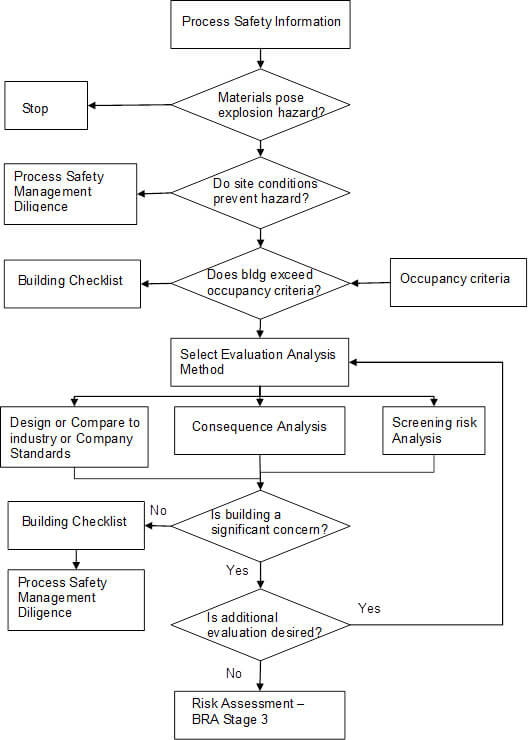Building Risk Assessment (BRA)
The building risk assessment shall evaluate the explosion, fire, and toxic release hazards using the three-stage process outlined by API RP 752. The Building Risk Assessment (BRA) Stage I and II shall include but not limited to the following steps, and is illustrated in the figure below:
- Identify major hazards to which the Buildings might be exposed, which may be from the operator or neighbouring facilities.
- Carry out consequence modelling as per Stage II BRA requirements and based on plant compositions, data and configuration for the facility.
- If the mitigation measures identified at Stage II for the buildings are cost prohibitive and impractical then perform a detailed Stage III BRA (Quantitative Risk Assessment, QRA) for major hazards.
- Identify and recommend appropriate prevention and mitigation measures for the building that are subject to unacceptable consequences from potential vapour cloud explosion (VCE), flammable cloud, fire and toxic hazards.
- Provide design explosion overpressure and impulse values for the buildings.
Figure 4‑1 – Stage I and II BRA flowchart
Building Risk Assessment (BRA)
The building risk assessment shall evaluate the explosion, fire, and toxic release hazards using the three-stage process outlined by API RP 752. The Building Risk Assessment (BRA) Stage I and II shall include but not limited to the following steps, and is illustrated in the figure below:
- Identify major hazards to which the Buildings might be exposed, which may be from the operator or neighbouring facilities.
- Carry out consequence modelling as per Stage II BRA requirements and based on plant compositions, data and configuration for the facility.
- If the mitigation measures identified at Stage II for the buildings are cost prohibitive and impractical then perform a detailed Stage III BRA (Quantitative Risk Assessment, QRA) for major hazards.
- Identify and recommend appropriate prevention and mitigation measures for the building that are subject to unacceptable consequences from potential vapour cloud explosion (VCE), flammable cloud, fire and toxic hazards.
- Provide design explosion overpressure and impulse values for the buildings.

